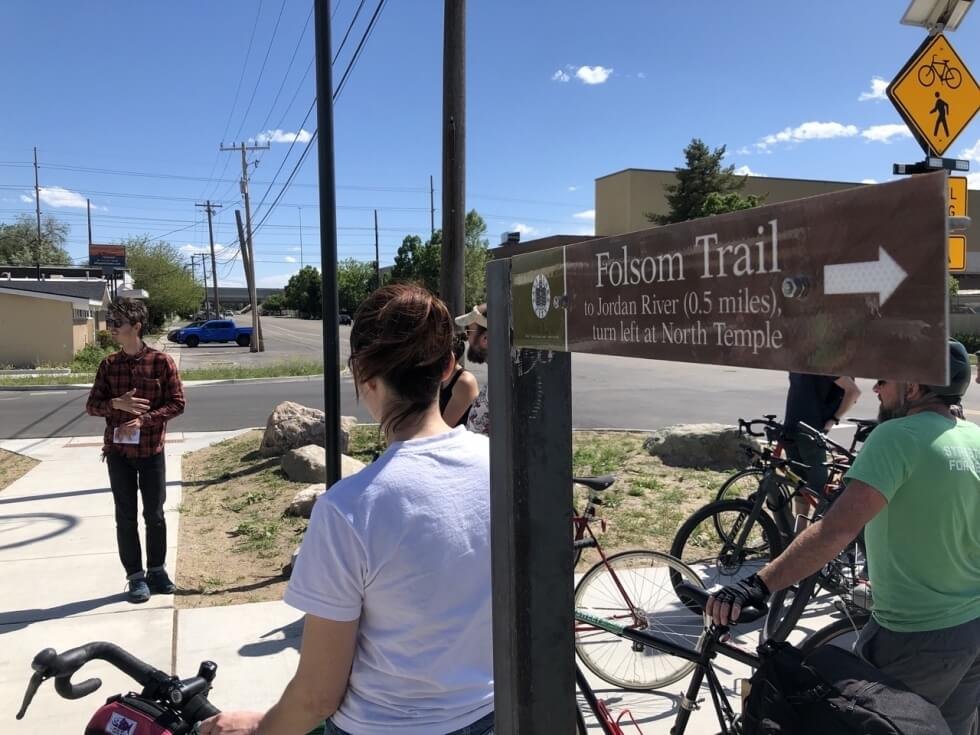Local infrastructure making strides in Westside walkability
The Folsom Corridor Trail is a 12-foot-wide, off-street path that offers pedestrians and cyclists an alternative to the main road. Located along the abandoned Folsom rail line, the trail connects 1000 west to 500 west and the North Temple FrontRunner Station. Thanks to efforts of local non-profit Seven Canyons trust, phase one of the Folsom trail was completed in December 2021.
According to walkscore.com, which calculates communities’ walkability, major neighborhoods on the Westside such as Rose Park, Fairpark, Glendale, and Poplar Grove have walking scores of just 50 or below out of 100. Downtown Salt Lake City, for comparison, has a walkability score of 85/100. This means that most neighborhoods on the Westside are not pedestrian-friendly, and in order to get around safely and effectively, people likely need access to motor vehicles. With the addition of walking paths such as the Folsom Trail, however, the Westside is beginning to feel easier to navigate on foot or by bicycle.
Brian Tonetti, Executive Director of Seven Canyons Trust, leads a tour of the new Folsom Trail pedestrian and cycling path.
“The vision here is to create a trail and creek corridor and key East-West connection between downtown SLC, a Frontrunner station, a Trax station, and to the regional Jordan River trail,” said Brian Tonetti, Executive Director of Seven Canyons Trust, an organization that works to uncover and restore the buried and impaired creeks in the Salt Lake Valley. Many of those creeks run through the Westside, which means areas all along the Westside are seeing improvements in walkability and green public spaces, such as the newly developed Three Creeks Confluence.
Seven Canyons Trust collaborated with Sweet Streets, another local advocacy agency, to offer a series of walking and bike tours to introduce Westside locals to the trail in late May. Sweet Streets also works to make streets safer for pedestrians and cyclists on the Westside. The most visible example of their advocacy is the “20 is Plenty” campaign, which petitions for residential streets to post speed limits of 20mph. With higher speed limits come higher risks of auto-pedestrian accidents, leading many to feel unsafe walking in their neighborhoods.
“We work on a variety of issues and think about ways that we can improve the way our city is designed to better encourage beneficial behavior from drivers. It’s not the enforcement or cultural ideals, we have to build the infrastructure to support the behavior we want to see from drivers,” said Shelby Stults, board member of Sweet Streets, during the Folsom Corridor Trail walking tour.
In addition to adding more walkable space to the Westside – and potentially improving the community’s walkability score – the Folsom trail also serves as a safe link between the Jordan River Parkway Trail, downtown, and beyond. The recent construction of the Folsom trail is part of just one project that has gone towards improving walkability and public spaces all across the Westside.
Safety and general walkability are crucial aspects of encouraging people to navigate their neighborhoods via foot or bike, and so is the availability of green spaces and shade . Tree Utah is one organization working to bring more trees and green spaces to the West Side. In conjunction with Mayor Mendenhall’s 2020 initiative to plant 1,000 trees per year on the West Side, Tree Utah has placed a major emphasis on planting trees here and to find ways to keep plant life thriving. By providing grants, volunteers, and the actual trees, Tree Utah is providing much needed support to West Side Residents in creating greener spaces.

